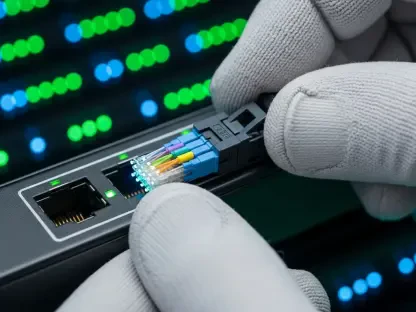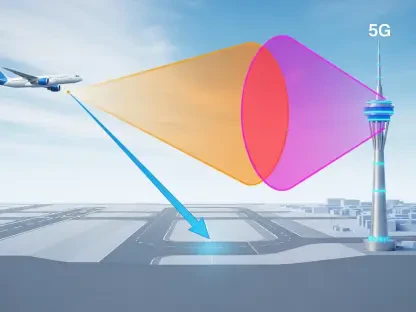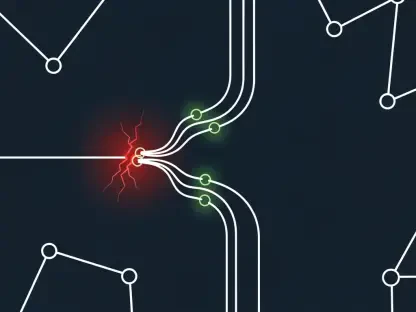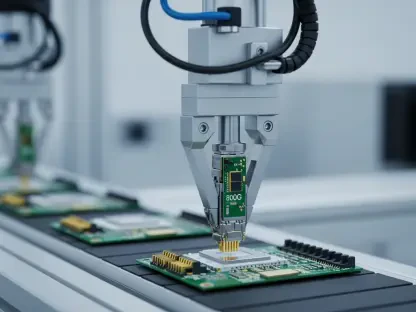As the Ethernet Alliance celebrates its tenth anniversary, it is showcasing a monumental roadmap that underscores the vital intersection of advanced Ethernet technology and the increasing demands of artificial intelligence workloads. This development will be a focal point at the upcoming Optical Fiber Communication Conference and Exhibition (OFC), where experts will delve into how AI is significantly influencing the trajectory of Ethernet development. The increasing integration of AI in networking requires sophisticated, high-speed Ethernet infrastructures capable of handling the large volumes of data and complex computations intrinsic to AI operations.
The Growing Role of AI in Ethernet Development
Peter Jones, chairman of the Ethernet Alliance, has highlighted the essential need to bring together various groups in order to build Ethernet infrastructures that are fully compatible with AI applications. Comparing this endeavor to coordinating a fleet rather than steering a single supertanker, Jones underscores the importance of aligning diverse factions brimming with innovative ideas and developments. He posits that achieving a cohesive, AI-ready Ethernet infrastructure is akin to the Dunkirk evacuation, where efficient coordination amid complexity is paramount.
The realm of Ethernet development is populated by major stakeholders such as Cisco, Arista, and Juniper, along with influential groups like the Ultra Ethernet Consortium and IEEE. These entities are collectively dedicated to refining and enhancing Ethernet technology to better support the rigorous demands of AI operations. The rapid advancement of AI presents significant engineering challenges, including managing congestion, reducing latency, curbing power consumption, and improving signaling efficiency. These challenges must be addressed to ensure the effective integration of AI within existing Ethernet frameworks.
Key Projects and Collaborative Efforts
Amidst ongoing developments, the IEEE P802.3dj project stands out, aiming to establish 200G per lane Ethernet standards by late 2026. Despite these ambitious goals, industry pressures indicate a pressing need for even faster solutions, with 400G per lane quickly becoming a necessity. John D’Ambrosia of Futurewei Technologies has elaborated on the essential signaling technologies paving the way for various Ethernet standards, ranging from 200GbE to 1.6TbE, set to be finalized in 2026. These advancements are critical for near-term applications that necessitate leveraging Ethernet for AI workloads, spotlighting the urgency of developing technologies beyond 200 Gb/sec signaling for future networks.
The Ethernet Alliance’s consortium’s 2024 Technology Exploration Forum (TEF) has thrown light on the engineering issues related to congestion management, latency, power consumption, and signaling. The forum emphasized the ever-growing demand for faster network speeds, reflecting the relentless pace at which AI technology evolves. It is essential for collaborative efforts to continuously address these issues, devising innovative solutions that effectively mitigate the engineering obstacles posed by rapid AI advancements.
Addressing Industry-Wide Challenges
One prominent realization from the TEF event asserts that achieving 400Gb/sec signaling is an industry-wide challenge, requiring collaborative efforts across multiple layers and components. In response, the IEEE launched an “802.3 Ethernet Interconnect for AI” assessment, a multivendor collaboration set to evaluate core requirements for Ethernet and AI interconnects. This project aims to assess necessary performance metrics, set developmental priorities, and strike a balance among attributes such as latency, resilience, reach, and power considerations.
The transition of AI networks from traditional InfiniBand connections to Ethernet frameworks is gaining momentum, propelled by both supply and demand dynamics. Large-scale AI clusters, such as xAI’s Colossus supercomputer, have begun to adopt Ethernet, reflecting a notable trend in the industry. Vice President Sameh Boujelbene of Dell’Oro Group underscores this shift, suggesting that Ethernet might eclipse InfiniBand as the preferred networking fabric by 2027. The momentum indicates a transformative period where Ethernet’s versatility and broad adoption will redefine its role in AI networking.
Wi-Fi and Campus Network Integrations
Extending beyond the realm of AI, Ethernet continues to maintain a crucial role within wireless and campus networks. The arrival of Wi-Fi 7 (802.11be) highlights Ethernet’s fundamental role in ensuring high-speed and low-latency connectivity for next-generation wireless networks. The synergy emerging between Wi-Fi and Ethernet is pivotal for developing scalable, high-performance hybrid networks. This convergence is set to enhance the capabilities and performance of wireless networking solutions, propelling seamless connectivity in various application environments, from educational institutions to corporate campuses.
Recent developments in Wi-Fi access points and client devices have been accelerating the adoption of higher-speed Ethernet. Transitioning traditional BASE-T ports from 1000BASE-T to 2.5G, 5G, and 10G, along with advancing optical ports from 10G/40G to 25G, 100G, and 200G, fosters enhanced capacity, efficiency, and scalability. These advancements are instrumental in meeting the escalating demands for bandwidth, ensuring reliable and swift data transmission within rapidly evolving network infrastructures.
Innovative Optical Solutions for Data Centers
Advancements in data center networking are driven by innovative optical solutions such as Co-Packaged Optics (CPO), On-Board Optics (OBO), and Linear Pluggable Optics (LPO). These technologies are designed to address the growing power consumption challenges associated with higher link speeds. They promise significant improvements in interconnect density between accelerators and chips, which is essential for handling the increased data loads generated by modern applications and services. By enhancing the efficiency and performance of Ethernet connections, these optical solutions are set to revolutionize data center networking.
However, it is important to note that CPO technology is not yet primed for widespread deployment across extensive networks. Its initial application scope is confined to chip-to-chip connectivity, facilitating higher interconnection density in environments with fewer interoperability constraints. Despite this limitation, the groundwork being laid by these optical technologies is crucial for fostering future Ethernet innovations. As these solutions mature and become more widely adopted, they will play an instrumental role in enhancing the overall efficiency and capacity of data centers.
The Future of Ethernet in Networking Demands
Celebrating its tenth anniversary, the Ethernet Alliance is highlighting a groundbreaking roadmap that emphasizes the crucial intersection of advanced Ethernet technology with the escalating demands of artificial intelligence (AI) workloads. This significant development will take center stage at the forthcoming Optical Fiber Communication Conference and Exhibition (OFC). At OFC, industry experts will explore how AI is profoundly shaping the future path of Ethernet technology. As AI becomes more integrated into networking, the necessity for sophisticated, high-speed Ethernet infrastructures capable of managing vast amounts of data and complex computations intrinsic to AI operations is increasingly evident. Modern AI applications require robust networks that can support the rapid processing and transmission of large datasets, a demand that existing Ethernet technologies are continuously evolving to meet. The collaboration between AI and Ethernet technology is anticipated to drive significant advancements in network performance, reliability, and scalability, paving the way for more efficient and powerful AI-based systems in various sectors.









